Spring 2012 A publication of the Wildlife Division—Getting Texans Involved
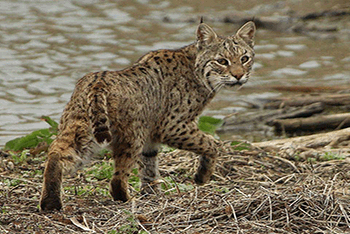 DFW Public Contributing to Urban Carnivore Research
DFW Public Contributing to Urban Carnivore Research
Photo © Chris Jackson
By Derek Broman
In the Dallas — Fort Worth Metroplex (DFW), Texas Parks and Wildlife's Urban Wildlife Office is currently involved with a collaborative urban bobcat research project that seeks to provide information on bobcat habitat, diet, and population demographics in an urban landscape. Products from this project will include estimates of bobcat habitat and maps that display suitable habitat throughout DFW. However, testing the quality and validity of these products requires additional information. For example, if a bobcat habitat map indicates large amounts of habitat occur in northwest Dallas County, how could we test that suggestion? A common solution is to see if anyone has viewed bobcats in that area, but where does that information occur? What about sightings in other areas of DFW? No robust repository exists for bobcat sightings across DFW. With 6.7 million people in DFW, surely the public is encountering bobcats or their sign (i.e., tracks, scat), right? To meet these needs, I created a project on the website iNaturalist.org to collect, store, and manage bobcat sightings in DFW. iNaturalist is a free website where you can document and share observations of plants and animals anywhere in the world. It is also an excellent resource for receiving assistance on plant/animal identification as others on iNaturalist provide recommendations on the identity of your observation, and sometimes these individuals are leading experts in their field. Each observation you make, whether added using the mobile phone app or manually on a computer, is stored to your personal library and includes date, time, and location (derived from the GPS on your phone or an interactive Google Map on your computer).
The project, called ‘DFW Carnivores’, allows anyone to submit observations of bobcats within the 10 central DFW counties (Collin, Dallas, Denton, Ellis, Johnson, Kaufman, Parker, Rockwall, Tarrant, and Wise). While bobcat sightings are imperative to the urban bobcat study, this project provides the opportunity to collect information on other rare or secretive carnivores (e.g., ringtail, mink), especially those listed on the Texas Wildlife Action Plan for the region (e.g., river otter, long-tailed weasel, mountain lion, eastern spotted skunk, and American badger). Therefore, the project also allows the submission of any carnivore observation in DFW in the hopes that TPWD can begin to detect and document the presence and distribution of focal species in a rapidly developing area. The DFW Carnivores project was created in August 2013 and as of mid-February 2014 is nearing 250 carnivore observations in 29 cities. As for bobcat sightings, 80 have been reported in 29 cities. While it can be extremely difficult to capture an image of an elusive, cryptic mammal, 93% of bobcat observations include a photo for identification (94% for all carnivore observations). This high percentage is likely the product of stationary objects such as bones, roadkill, tracks, and scat being observed and photographed but many photos have been taken with use of remote-triggered trail cameras (i.e., game cameras). I was surprised to learn so many of these cameras were being deployed in urban areas.
A few unexpected observations include mink and river otter. Although the number of reports is currently low, mink have been observed in Dallas and Tarrant Counties, and river otters in Collin, Dallas, and Denton Counties. These animals have not been previously observed in these areas, thus iNaturalist has been immediately valuable in informing the DFW Urban Wildlife Office.
In addition to indicating species presence and distribution, data reported to iNaturalist may be used for other investigations. For example, should data reach sufficient levels, a future goal is to derive information on habitat use from those reported observations to construct species-specific habitat models and maps. Should that technique prove valid, the use of public reported information (i.e., citizen science) could eliminate the need for intensive field investigations and serve as an immensely valuable tool in wildlife conservation. The presence and distribution of certain animals can also provide insight on habitat health. For example, mink and river otter populations are often associated with high water quality and good riparian areas. Their presence may very well indicate good aquatic health within DFW.
As public awareness increases of iNaturalist and the DFW Carnivores project, I am optimistic that observations of bobcats and other carnivore species will continue to increase. I strongly encourage you to use iNaturalist to store your personal plant and animal observations, and to help get information to wildlife biologists that need it. Also, please consider sharing your observations on TPWD-managed iNaturalist projects such as the Mammals of Texas, a project to share observations of carnivores inside and outside the DFW Metroplex.
Derek is an urban wildlife biologist in the Dallas — Fort Worth area.
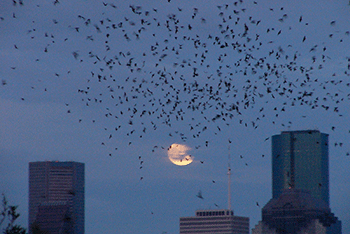 Nature Tourism and the Value of City Bats
Nature Tourism and the Value of City Bats
Photo © D. Humes
By Diana Foss
Bats are often shrouded by myths and erroneous movie stereotypes. But the real fact is that bats are highly beneficial, providing significant services to people and ecosystems, including cities! Bats living in urban areas often receive a mixed welcome when discovered. It's the ‘eeek’ factor that initially affects people. However, in many Texas cities, the ‘eeek’ is turning to ‘chic’. Besides the nightly insect control, cities are now valuing their bats for nature tourism dollars and outdoor recreation opportunities. Bats provide crucial natural pest control nightly. For example, the million plus Mexican free-tailed bats residing in Austin‘s Congress Avenue Bridge eat an estimated 20,000 pounds of insects nightly. A recent study to determine the value of bats in controlling agricultural crop damage to corn and cotton in an eight county region in Texas, estimated the bats’ value at $741,000, with a range of $121,000 to $1.7 million (primarily in reduced need for pesticides). The bats ate the moths responsible for producing the caterpillars causing the damage. Even bat guano has value as natural fertilizer, as a component in rich compost, and even historically as a component in saltpeter to make gun powder back in the 1800s.
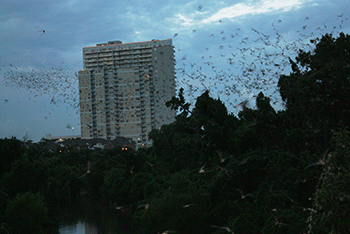
While most people never notice the bats living around them, there can be great value in bats being seen. On a recent summer night in Houston, several dozen people were enjoying the spectacle created by approximately 300,000 Mexican free-tailed bats emerging from Waugh Drive Bridge in Houston. Visitors included a wide range of cultures; local residents and tourists from other states, bat researchers from Great Britain, a family from Spain, and a gentleman from Denmark visiting his family in Houston. The man from Denmark had just arrived at Bush Intercontinental Airport on the north side of Houston that afternoon. Employed as a bus driver in Denmark, he had heard about Houston’s “bat bridge” from a regular rider on his bus, and when he mentioned traveling to Houston to visit family, he was told “You must go!” So the man’s son and grandson arrived to pick him up, and then whisked him immediately to the bridge in time to see the bats fly out against a blazing sunset. The family experienced an awesome bat emergence, learned some bat facts, and drove home as happy new bat ambassadors.
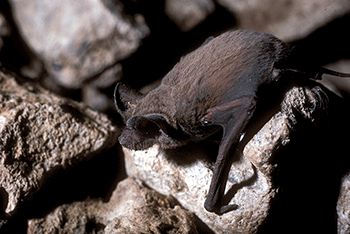
Unwittingly, the bats are also representing the city. Amongst the glass and steel of the downtown buildings, a simple concrete bridge holds such interesting life. Tourists add the evening spectacle to their lists of “must sees” as they eat in local restaurants, sleep in area hotels, rent vehicles, purchase fuel, and obtain souvenirs to mark the visit. A recent study conducted by the U. S. Geological Society and University of Arizona, conservatively estimated that the tourism value from 242,000 visitors viewing bats at 17 roosts in six states for one year equaled over $6.5 million in consumer spending. That’s ‘bat’ money flowing into local economies. Bat viewing often sparks local industries: from evening cruises down the river to watch the bats emerge, to restaurants offering evening specials as patrons sit outside and observe the bat emergence. Commercial Segway tours and bicycle rentals enable transportation to bat-watching destinations. Tours and tour guides have sprouted up, interpreting bat behavior to willing crowds. Nationwide, bats incite entire events, like ‘Bat Days’ and ‘Bat Festivals,’ and even the United Nations ‘International Year of the Bat’.
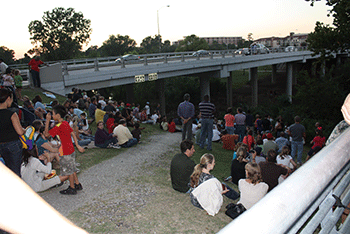
Bat conservation among urban development can be tricky, especially when dealing with bridges. In the greater Houston area, a TPWD urban wildlife biologist with a team of volunteers is undertaking a project to document known bat roosts, especially those in bridges. Using maps of existing bridges, knowledge of typical bat behavior, along with reports from the public, the ‘Bat Team’ will check specific bridges and collect data on any bat roosts discovered. The resulting roost database will be useful to agencies and companies planning construction projects in the Houston area. The construction project team can then work ‘with’ the bats during the course of their project, thus protecting the bat colony and roost, as well as their workers. In a great example of cooperative efforts to enhance a local natural area while protecting bats, Buffalo Bayou Partnership, Millis Construction, Harris County Flood Control, Harris County Public Infrastructure, and several architectural/landscape design companies are carefully working around a large bat colony near downtown Houston during a major trail and greenspace project along Buffalo Bayou. In response to advice and requests from the volunteers who have studied the bats for years, the project team has modified their design for construction under and adjacent to the colony, and shifted their schedule for construction to times of the year when it would impact the bats the least. Kudos to them for their efforts and flexibility! So please take the time to stop what you’re doing, sit down and watch a bat…or many! There are lots of benefits packed into those little bodies. And if you spot a large bat roost, please consider reporting the site to the database team (diana.foss@tpwd.texas.gov).
Diana is an urban wildlife biologist in Houston
Managing Your Property for Wildlife
By Judit Green
Every day for the past 9 years I have driven along my usual route heading to my office located on a State Natural Area just outside of San Antonio. Leaving my neighborhood’s city streets lined by homes with turf grass lawns and arriving to this beautiful rural drive where an array of plants fill the understory of large canopy trees alongside this two-lane road sets the tone for my day. But alas, development has caught up to this area. Subdivisions have moved in along this road to the point that expansion of this quaint rural road is now necessary. The city has cleared a substantial amount on either side of the road and it saddened me to see the bulldozed trees now on their sides. Clearing land of plantings that took sometimes hundreds of years to grow is often done in a day or weekend which can have grave consequences for wildlife. As I see cities growing at an expansive rate, I realize the urgency in trying to get property owners, regardless of the size of their property, to realize the various options available to them in managing the land so that it can benefit people, but not at the cost to our wildlife, native landscapes, and water.
Texas is a state without statewide land use planning and it gives the power of how to develop to its cities, often without input even from the county. This often leads to poorly planned, often chaotic patterns of development across the landscape since there is no methodology offered by the state. In addition, many absentee landowners who own tracts of land in rural areas they don’t reside on, often manage their lands in the way they are used to doing in the city–removing unknown, unwanted weedy-like plants in an attempt to “clean up” the property. They often don’t realize the value of their landscape and all too often seek out my help only after valuable habitat has been destroyed.
Unless Texans help to change the way this state develops into the future, it is even more paramount that each person that owns land, no matter the size be it urban or rural, take into account what their piece of Texas means to future generations as well as to the natural resources found on their property. So what is a landowner to do? Here are a few tips:
Landowners with smaller properties may be limited as to what they can do on their land for wildlife. Birds, because they have no boundary limitations, are the easiest species to manage for on any size property regardless of location and the habitat will benefit a host of other species too!
One of the most important things you can do for wildlife is to retain the native plants you have on your property. If you have little to none on your property, then re-plant sites with natives. Plants are valuable to wildlife for the food it offers (nectar and fruit, as well as the insects it attracts), the nesting opportunities, and the shelter it provides from weather and predators. For new owners I recommend taking a couple of years to identify the plants you have before you start clearing anything from your property. This will save you time and money from having to replant your property in the future. The best time to identify plants is when they are in bloom and leaves are present on the plant. A good field guide for plants will showcase these two features. These initial records will serve as your baseline inventory as you move forward in improving your land’s habitat.
If at all possible, avoid fragmenting the property into smaller tracts. This is often done as property is passed down or sold to others. As properties become smaller, they tend to be cleared by the various owners leaving little valuable habitat for wildlife. Urbanization and development are additional reasons for habitat loss and why we are seeing a huge decline in our wildlife populations as well as water quality.
Another key element of good land management is to offer a variety of different plants. That means not just providing canopy trees, but also retaining or planting understory or various shrubs beneath them. This is especially important in urban areas where most properties only have tall trees and don’t offer many native plants. These “islands” of thick undergrowth are magnets for birds that are drawn to the food, cover, or nesting sites these areas offer. In open fields or meadows allow native grasses to grow which will draw in grassland birds and mammals that feed on the seeds and use the grasses for nesting material. In addition, larger birds of prey such as hawks and owls will feed on any small mammals drawn to area. For more information about sowing native plant seeds yourself, visit www.seedsource.com.
In your wooded areas, allow trees that have fallen to remain in place so they can decay over time, attracting insects for birds to eat. Keep dead or dying trees intact on your property since they too will attract insects and they will also attract woodpeckers which will excavate cavities for rearing their young. Once they vacate, other birds and mammals may enlarge the hole, making it suitable for their nesting needs too.
Allow your land to recuperate from past land practices by doing nothing for a couple of years. Dormant seeds that reside in the soil may germinate over time. It will be up to you to identify what grows and whether it is wanted or not. Birds often spread seed from their favorite fruits as they perch in your trees or along a fence line–these are the plants they favor most, so don’t be too quick to remove them unless they are on the invasive species list (www.TexasInvasives.org).
There are a variety of resources available to landowners. Texas Parks & Wildlife biologists offer free technical guidance and offer regular workshops for both urban and rural landowners. Contact your nearest urban wildlife office for assistance at www.tpwd.state.tx.us.
Judit is an urban wildlife biologist working out of the San Antonio office
Texas Wildscapes and Texas Water
By Mark Klym
Rain – a precious commodity anywhere in the Lone Star State. The water we have is under increasing demand to refresh our thirsty cities and quench our parched crops. Water is precious, and scarce, yet often one of the easiest ways we could conserve water, and one of the most effective, is completely over looked.
The Environmental Protection Agency estimates that the average American uses about 320 gallons of water daily, of which 30% or 96 gallons is used outside and half of that (48 gallons) is used on our lawns. That is daily use! In dry areas such as Texas, daily outdoor use can account for as much as 60% of our average daily use. Nationwide, water used for our lawns accounts for nearly 9 billion gallons of water daily.
As we can see, lawns and gardens are a significant part of our water use, and if we can find a way to reduce the water consumption of our gardens, we can have a definite impact on water demand and thus on water conservation in Texas.
The first thing we should do is check our irrigation methods and equipment to ensure we are not wasting water. That same EPA article estimates that 50% of the water used to irrigate our land is wasted (4.5 billion gallons daily)! Waste can come from over watering (most grass does not need to watered daily, or even every other day). Another source of loss is sprinklers and other aerial watering methods that overspray throwing water onto the hardscape. This water just runs off the property or is evaporated with no benefit to wildlife or the landscape. Much of the water thrown into the air by sprinkler systems is evaporated – especially if you water near midday. Leakage, from poorly connected or damaged equipment, is another huge source of water loss.
The most significant impact we could have on outdoor water use though would come from the proper selection of regionally native plants to use in our landscape. While these are not the most popular of plants, and you generally will not find them in the “big box stores,” they are the plants that have demonstrated the ability to not only survive, but to thrive in our variable, but dry, Texas climate.
Texas native plants are a good start, but if you can select plants that naturally occurred in your region, relatively close to your property, you are going to have the greatest success, contribute most to the ecology of your area and conserve water. These plants have developed to thrive not only in the water conditions and the weather common to the region, but also in the soils of the area and with the other biota (life) in the region.
But what is a “native” plant? If the plant has been here for a certain time should it not be considered “native”? It can thrive on its own, without any assistance from me – surely that counts for something! What about plants recommended by garden centers and other sources as great for the region?
A truly native plant is one that would have been here without any assistance from man. We don’t know with certainty how much trade and transport in plant materials there was before European man arrived in Texas, but we do know that after the arrival of European man the number of exotic plants increased significantly. Generally, a plant that was here and is recorded in the writings of some of our earliest naturalists is considered a native plant.
Since Wildscapes requires the use of native plants as a majority of the plants in your garden, and since these plants are known to thrive in our drought and flood environment, Wildscapes is a great way to reduce your impact on Texas’ shrinking water supplies. Check out www.tpwd.texas.gov/wildscapes for more information.
Mark coordinates the Texas Wildscapes program out of the Austin office.
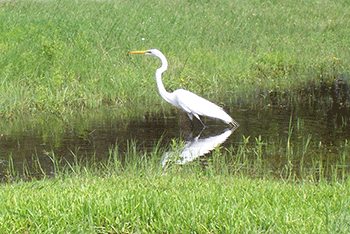 Heronries in Urban Areas: Living with Cattle Egrets
Heronries in Urban Areas: Living with Cattle Egrets
by Brett Johnson
“They are such pretty birds!” “These birds are driving me crazy!” “They don’t hurt anyone. Can’t we just leave them alone?” and “There is bird poop literally everywhere.” These were all statements that I heard for the first time in 2010, and then again in 2011. Envision the following scenario. Starting in 2009, you noticed probably fewer than 50 Cattle Egrets starting to nest around the neighborhood. In 2010 this number increased to a couple hundred. In mid-February, 2011, you noticed about 8 stout, football sized, neat looking black and white birds that walk around during the day and fly around at night. This is the Black-crowned Night-heron. About a week later, they are actively building nests, and a few days later laying eggs. We’ll talk about them more here later. In mid-March, the number has increased to 100 Cattle Egrets hanging around. About 3 days later, that number has grown from 100 adult birds, to about 1,000 adult birds. By mid-April, the Cattle Egrets have built nests in the trees of 12 houses (avg. 2 trees per house—we’ll call it 24 trees). Each tree has about 50 nests, each nest has 2 adults and an average of 4 fledglings. Simple math plays out to potentially 7,200 Cattle Egrets. All concentrated into a fairly small area. This doesn’t include the Little Blue Herons, Snowy Egrets, Tricolored Herons, and Great Egrets that are also present, but in much lower numbers.—Keep in mind, all these species tend to come back to the same area in which they were born.
In June 11, 2011, our office was called by city staff. “I know that there’s
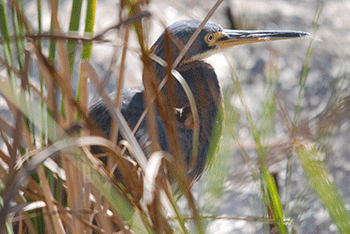 probably not anything you can do, but can you please just come out and see what we are dealing with”. I agreed to visit, but didn’t expect what was waiting for me. How bad could it be? How wrong could I be? From sunrise to about 2 hours after sunset, there was constant, loud squawking. The streets were stained with bird fecal matter. Sidewalks are covered in bird fecal matter, and in some places the fecal matter was 2-4 inches deep. Residents were concerned over a host of potential diseases. Houses for sale on the street had to be pulled off the market. I agreed with a colleague who said “There is no way I would want to live here, I really feel sorry for these people.”
probably not anything you can do, but can you please just come out and see what we are dealing with”. I agreed to visit, but didn’t expect what was waiting for me. How bad could it be? How wrong could I be? From sunrise to about 2 hours after sunset, there was constant, loud squawking. The streets were stained with bird fecal matter. Sidewalks are covered in bird fecal matter, and in some places the fecal matter was 2-4 inches deep. Residents were concerned over a host of potential diseases. Houses for sale on the street had to be pulled off the market. I agreed with a colleague who said “There is no way I would want to live here, I really feel sorry for these people.”
How did this neighborhood get in this situation? The Cattle Egret is a species originally native to Europe, Asia and Africa. Following the increase in cattle production worldwide, they have had the fastest and largest range expansion seen in birds. They first appeared in Florida in the 1940’s, and had a breeding population in the US by the early to mid-1950’s. They are actually a grassland species (though they associate with wetland species quite a bit) that has a penchant for grasshoppers. They have a lot of flexibility too in their requirements for their heronry. They like a thick, mature canopy, but are not picky about what trees make up the canopy. Boiled down, they can do pretty well in urban settings.
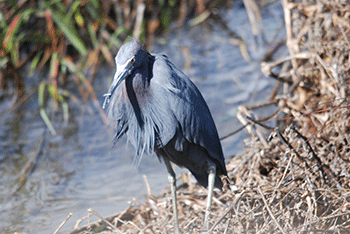
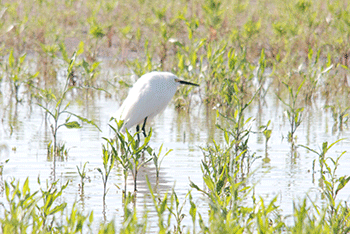 What about diseases? Is this a public health issue? Though many can potentially be found in a heronry (including histoplasmosis, salmonella, and E. coli), none have ever been demonstrated to occur in a heronry. Wildlife and public health officials have attempted to find nuisance heronry solutions by raising public health concerns, but their inability to prove the point with laboratory tests have resulted in municipalities only being able to cite personal sanitation concerns, as opposed to public health.
What about diseases? Is this a public health issue? Though many can potentially be found in a heronry (including histoplasmosis, salmonella, and E. coli), none have ever been demonstrated to occur in a heronry. Wildlife and public health officials have attempted to find nuisance heronry solutions by raising public health concerns, but their inability to prove the point with laboratory tests have resulted in municipalities only being able to cite personal sanitation concerns, as opposed to public health.
So what can be done to avoid this issue, and benefit both residents and the birds themselves? The The TPWD Urban Wildlife Program provides resources for urban residents dealing with both heronries and nuisance heronries. Once the issues are understood, and stakeholders are gathered and informed, a solution can be worked out. Often that solution includes nest removal during the non-nesting season. The key is planning several months out, starting in the fall. In about the second week in October, when the birds are gone, the nests can be removed from the trees without a permit. Then the mid-canopy needs to be thinned to make it harder to nest, and so herons can’t freely walk between trees. Then, identify those areas where they may move if they do move (i.e. mature canopies, usually subdivisions put in between 1950 and 1970). Identify areas too where it is completely ok if the birds move into (sanctuary areas). When the birds first show up, there are a variety of legal means that can be used to harass them and encourage them to move (flash bangs, lasers, scare-eye ballons, water hoses, etc). Usually 2 or 3 methods must be used for about a week. Make sure you work with stakeholders to build consensus for such a solution. Also ensure that local ordinances are reviewed with city leaders and local law enforcement to develop a solution. If the window for action is missed (usually mid-October until early February, until the first egg is laid in a colony), the only entity that can legally harass or kill birds is USDA-Wildlife Services. Their involvement is contingent on whether they have a formal agreement in the County or City where the heronry formed.
Did it work? We went from 1,000 plus nests in 2011, to 10 active nests in the whole city in 2012. Eight were found in the original neighborhood. Residents were pleased it worked out, and no birds were killed. The city has been diligent the last 2 years, and did a great job. The model works if it is needed. Remember the key is minor habitat modification and early detection.
Brett is an urban wildlife biologist in the Dallas- Fort Worth area.
Home Owner’s Association and Citizens Work to Combat Feral Hogs In The Big City
By Keith Crenshaw
When you think of Houston, you might think of the museum district near downtown. You might think a little greener and go to Memorial Park. Most others think of Houston as bright lights and asphalt. Citizens of Kingwood, a suburb on the Northeast outskirts of Houston, live in their community dubbed ‘The Liveable Forest’. Last winter when most were thinking of their Christmas holiday and the hustle and bustle of the end of the year, the citizens of Kingwood were introduced to the most prolific invasive mammal in the state. After land along Lake Houston had been cleared to put in a subdivision, Feral hogs made their way into the outskirts of their Kingwood neighborhood.
Feral hogs have been around Texas since the Texas–Mexico War for Independence. Now Feral hog populations are over 2 Million in number in Texas. Feral hogs are not just a Texas issue. They reside in 38 other states and four Canadian provinces. In Texas alone, they do approximately $52 Million in damages each year. Texas allows hunters to harvest feral hogs year–round without limits or capture them alive to take to licensed slaughterhouses to be processed and sold to restaurants as exotic meat. The goal is not eradication, which few believe possible, but population control.
The wily hogs seem to thrive in almost any conditions, climate or ecosystem in the state—the Pineywoods of east Texas; the southern and western brush country; the lush, rolling central Hill Country. Other than Man, feral hogs have few natural predators, and there are no legal poisons to use against them. Sows begin breeding at 6 to 8 months of age and have two litters of four to eight piglets—a dozen is not unheard of—every 12 to 15 months during a life span of 4 to 8 years. They are highly prolific breeders and without a concerted effort to control populations, even pig populations reduced by 70 percent return to full strength within two or three years if efforts are not continued.
Wild hogs are “opportunistic omnivores,” meaning they’ll eat most anything. Using their extra–long snouts, flattened and strengthened on the end by a plate of cartilage, they can root as deep as three feet. They’ll devour or destroy whole fields—of sorghum, rice, wheat, soybeans, potatoes, melons and other fruits, nuts, grass and hay. Farmers planting corn have discovered that the hogs go methodically down the rows during the night, extracting seeds one by one. They'll do the same thing to an urban yard.
Hogs erode the soil and muddy streams and other water sources, possibly causing fish kills. They disrupt native vegetation and make it easier for invasive plants to take hold. The hogs claim any food set out for livestock, and will eat snakes, lizards, and eggs out of ground nesting birds. In urban areas, this process is even more prolific with yards under irrigation system management. A golf course or well taken care of yard is highly sought after by free roaming feral hogs.
Citizens in Kingwood are no strangers to wildlife. It is not uncommon to see the occasional deer, rabbit, or even a coyote moving through the community. Most golf courses in the area have had to engage in direct management to reduce feral hogs on their properties.
This past year, with a new pathway opened up for the exploding feral hog populations, they discovered the neighborhoods of Royal Shores and the lush lawns full of food. Citizens began contacting local Texas Parks & Wildlife Officials for help as their front yards and landscapes were being uprooted. A plan was set up between the local Kingwood Services Association (the Local Home Owner’s Association that manages five major parks) and the active citizenry to begin trapping hogs. Local citizens adjacent to East End Park purchased a box trap and shared in the efforts to remove feral hogs. Ethyl McCormick with Kingwood Services Association (KSA) aided the local citizenry by closing down East End Park at night and hiring a hog trapper to remove feral hogs at night.
With a concerted effort, over 20 hogs were removed between the citizenry and the KSA. Thirty days later, at the monthly KSA meeting, a report on the impact of the community working together to reduce the feral hogs was applauded with a standing ovation.
Feral hogs are a highly resilient animal that has been around for over 300 years. With a plan of action, effective implementation, and continued vigilance, Kingwood residents could return to being the livable forest that its citizens continue to enjoy.
Keith is an urban wildlife biologist in Houston.
Urban White-Tailed Deer
By Jessica Alderson
White-tailed deer (Odocoileus virginianus) can pose a growing urban wildlife management problem in many metropolitan areas throughout the United States. As urban sprawl increases, the natural habitat required by many wildlife species disappears, but white-tailed deer are able to adapt to urban environments and human activity. White-tailed deer populations can grow rapidly in some urban areas due to: the lack of natural predators, patchy habitats, limited hunting, increased production and survival of offspring, abundant food resources, and tolerance of human activities.
When humans and wildlife live close to one another, an increase in human-wildlife conflict can occur. Most human reactions to wildlife are based on previous knowledge and experience with the species involved. Usually, when deer first appear in urban habitats, humans consider them to be beautiful, non-threatening, and a highly valuable wildlife resource. However, when deer “cross the line” beyond what is perceived as acceptable versus unacceptable behavior, conflicts may arise between deer and people. Residents then start to weigh their full range of options concerning urban deer management.
Urban deer can cause a substantial amount of economic loss to humans through property damage, personal damage in deer-vehicle collisions, and disease risks. Residents seldom want to completely eliminate the deer population, but any management technique can become a controversial issue. For instance some people may want the deer to be removed or controlled using nonlethal methods, while others will support lethal management methods due to unpleasant encounters with overabundant urban deer herds. Negative encounters, such as deer-vehicle collisions, receive the highest priority by stakeholders involved in the decision –making process concerning management options. For example, substantial increases in deer-vehicle accidents resulting in property damage, injury, or death will usually tip the balance in favor of more aggressive urban deer herd management plans.
There are a variety of solutions when dealing with rural white-tailed deer, but some of these options may have limited success in urban settings. For example, hunting is an effective method for controlling overabundant urban deer but may not be legal within some city limits.
Many residents in communities with overabundant deer populations ask the question “Who is responsible for urban deer management?” The responsibility of deer management in urban areas typically includes residents, city officials, and citizen organizations such as property owners associations. The Texas Parks and Wildlife Department (TPWD) is not responsible for making management decisions or implementing management strategies for white-tailed deer on private property. The primary role of TPWD is to provide technical guidance and education for communities facing deer management problems.
Feeding deer may be tempting, but research has shown that supplemental feeding leads to increased disease risk, long-term habitat destruction, increased deer-vehicle collisions, habituation to humans and alteration of other deer behavioral patterns. Several Texas communities have implemented a city ordinance which prohibits the feeding of deer, restricts public access to deer management areas, and assigns penalties for damage or destruction of deer management equipment. Violators are charged with a Class C misdemeanor punishable by a fine determined by the city. Many of these cities have seen a healthy decline in deer numbers and nuisance behaviors.
There are nonlethal and lethal options for managing white-tailed deer in an urban landscape. Nonlethal methods can modify the behavior of deer, restrict access to certain areas or encourage deer to leave the immediate area. Some nonlethal methods, such as repellants, provide a short-term fix while others, such as high fencing, can be a long-term solution to human-deer conflicts. Non-lethal management options include: fencing, habitat modification, deterrent techniques and Trap, Transport and Transplant (TTT). Lethal methods reduce white-tailed deer populations by Trap, Transport and Process (TTP), or harvest of deer through regulated hunting. Processed deer meat from TTP is donated to approved charitable organizations like Hunters for the Hungry or local food banks. Regardless of which management plan is implemented, it is important to understand that urban deer management requires long-term efforts to achieve and maintain wildlife management goals. Applying a combination of several techniques will be more successful than utilizing one single method.
Education and communication with the public and other stakeholder groups is a key factor in reducing conflict within the community. The primary goal of communication is to educate all stakeholder groups so they can make well informed choices about where they stand on an issue. It is important to inform the public about all aspects of the issue, not just information that will persuade them in a certain direction.
The most challenging aspect of white-tailed deer management in the urban landscape is the issue of how to best manage deer where community residents often have highly polarized views and values regarding deer management. Successful resolution of urban deer issues requires that community leaders and TPWD staff work together with stakeholders to gain acceptance of an urban deer management plan.
For more information about urban white-tailed deer management:
TPWD Urban Wildlife Offices
http://www.tpwd.state.tx.us/huntwild/wild/wildlife_diversity/urban_program/
Overabundant Deer
https://www.tpwd.state.tx.us/huntwild/wild/game_management/overabundant_deer/
Managing Overabundant White-Tailed Deer
http://trinitywaters.org/media/2948/managing_overabundant_deer.pdf
Jessica is an urban wildlife biologist in San Antonio.
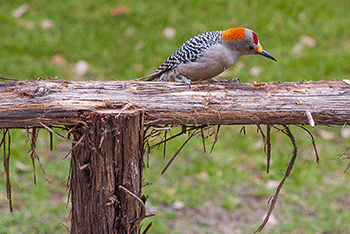
Urban Wildlife
Even a citified yard can be a nature haven
By Sheryl Smith-Rodgers
“He’s coming!” During the day, I often holler news flashes at my husband. Seated at my desk, typing on a project, I can hear the Golden-fronted Woodpecker before he alights on a wooden suet feeder in our back yard.
Chuh chuh chuh…chuh chuh chuh….
Pausing from my work, I turn to look through the mini blinds of a nearby window. Then I get up for a better view. Chuh chuh chuh… Sure enough, right on cue, here comes the woodpecker, hopping down a live oak branch, still calling as he approaches the feeder that’s fashioned from a cedar pole. Chuh chuh chuh…
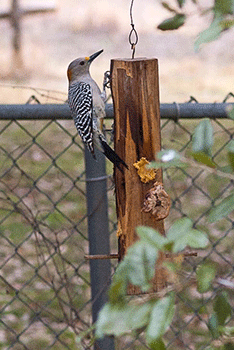
“He’s here!” I holler at James, who’s working at the other end of the house. By now, the woodpecker–red crowned and black striped–is pecking at the peanut butter mixture I’ve pressed into the feeder's four holes. While I watch, I yell out periodic updates.
“He’s eating!”
“He’s still there!”
“He’s hasn’t left yet!”
“Okay, now he’s gone!”
Go ahead, call me crazy (my husband does), but–wherever I may be–I brake for nature. Even the smallest beetle scuttling across a rock can pique my curiosity and cause me to bend down for a closer look. Or a new-to-me plant species may catch my attention. Every day, whether I'm inside or out, there’s always something different to observe or discover. That's because nature abounds in our yard, a wildlife haven located just a few blocks from downtown Blanco in the Texas Hill Country.
No more typical
When I first moved into this home in 2002, the yard–which stretches across two city lots–hosted two rose bushes, a crepe myrtle, exotic honeysuckle and a bed of irises, all surrounded by towering live oaks and ‘Floratam’ grass (a St. Augustine cultivar). Then I married my husband, James Hearn, in May 2006. He doesn’t like to sit still for very long. So we got busy and planted a few new additions. Like an American beautyberry. Some yellow columbines and red salvias. A flame acanthus and a rock rose, too.
A year later, while online, I ran across Texas Wildscapes, a habitat restoration and conservation program sponsored by the Texas Parks and Wildlife Department. Hmm, we certainly met the basic criteria of at least 50 percent native plants in our yard. We also provided year-around water, food and shelter for wildlife. So I filled out the paperwork and mailed off our application. Presto–our yard was designated as a Texas Wildscape.
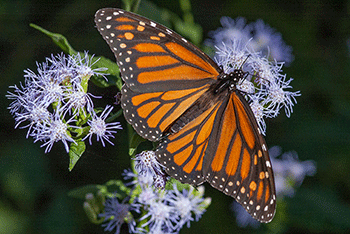
A female monarch nectars on a blue mistflower (Conoclinium coelestinum).
Nearly eight years later, our yard has evolved from a typical ho-hum lawn into a dynamic garden, where drama unfolds daily. Like woodpeckers flying in for a snack. A pipevine swallowtail depositing eggs right before my eyes. A turkey hen parading across the back yard. Texas spiny lizards scuttling up our huge live oaks.
Plant selection
James and I live frugally so the process of replacing grass with walking paths and rock-bordered beds has been gradual. Remember, our property stretches across two lots. Plus, we purchased an adjoining lot, which we’ve dubbed The Meadow and have allowed to grow more “natural.”
One of our earliest additions was Gregg’s mistflower (Conoclinium greggii), a perennial ground cover that dies back in winter but enthusiastically spreads each spring (and transplants like a charm). A butterfly favorite, the sky-blue fringed flowers attract queens and monarchs by the score in the fall.
Those clouds of butterflies encouraged us to plant other members of the Conoclinium genus. Blue mistflower (Conoclinium coelestinum) soon became a favorite. More like a long-branched shrub, this mistflower also dies back but returns even more robustly the following year. Butterflies, moths, bees and other pollinators flock to its blue-fringed flowers, the last to bloom in the fall.
In growing our Wildscape, we’ve followed no hard and fast rules, other than experimenting with Texas natives and learning what grows best in our yard. We’ve had a few casualties, like pigeonberry, blue-eyed grass, and chocolate daisy. But overall, the natives we’ve chosen and planted have survived well.
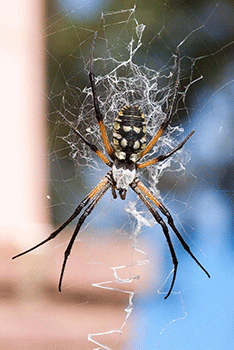
This female garden spider (Argiope aurantia) laid
four eggs in summer 2013 in the Blanco wildscape.
So what is a “native” plant? By loose definition, the term means plants that were growing here before the first European settlers arrived. “Naturalized” plants, such as common mullein (Verbascum thapsus), were introduced by man in the past 300 years. Since then, they’ve spread and adapted well to our landscapes. Aggressive naturalized plants that crowd out native plants are “invasive” or “noxious weeds.” Prime examples are waxleaf ligustrum (Ligustrum japonicum), Chinese tallow (Triadica sebifera) and bastard cabbage (Rapistrum rugosum).
To be honest, we haven’t exclusively planted natives in our yard. In the beginning, we didn’t know any better. Now we do. Over the years, we’ve planted passionflower vines, a host food plant for Gulf fritillary caterpillars. But we’ve also since added two species that actually grow in Blanco County: Passiflora lutea and Passiflora tenuiloba.
Our Wildscape also features two Blanco County natives–scarlet leatherflower vine (Clematis texensis), which I spotted growing in Blanco State Park, and climbing snapdragon vine (Maurandella antirrhiniflora), which thrives on limestone ledges on the outskirts of Blanco.
In the Meadow, I’ve spread seeds from native milkweed plants–antelope horns (Asclepias asperula) and purple milkweed vine (Matelea biflora), both of which I found already growing there. By accident, I also discovered a new-to-me milkweed species–zizotes (Asclepias oenotherodies) in the Meadow. Monarch larvae feed exclusively on milkweed species so any help we can provide is a huge benefit for the struggling butterfly species. Likewise, encouraging and planting these area-specific natives and many others in our yard benefits the other native insects, birds and other animals that live here.
What about deer? Oh, yes, at least five roam our neighborhood (they’ve worn a path across the Meadow). Generally, they seem to shun the available plants in our front yard, which include a variety of salvias, flame acanthus, Mexican bush sage, rock rose, and red columbine. However, we’ve noticed that they do enjoy chomping on our fall aster. Still, it manages to survive.
Other garden additions
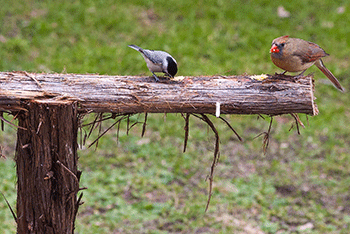
A Carolina chickadee and a female northern cardinal dine on suet.
In our Wildscape, we’ve also put up nest boxes for screech owls and solitary bees. Bird feeders provide black sunflower seeds, thistle seeds, homemade suet, and sugar water for hummingbirds.
Because of the rich diversity, every day’s a joy in our yard. No matter the season, something’s always happening. In mid January, a Cooper’s Hawk dined on a carcass high in one of our live oaks. A week later, a Carolina Wren perched and sang atop a dry concrete fountain for a straight hour while we watched from our dining room window.
Through the years, I’ve learned so much about nature simply by what I’ve observed in our yard (again, check out my blog). But most importantly, I’ve come to realize that we must all plant natives in order to replace the natural habitat that’s being lost fast to development and non-native vegetation, especially in the Hill Country.
Wait a minute, excuse me. I think I hear a woodpecker calling….
Sheryl’s favorite Texas natives
American beautyberry (Callicarpa americana) Fb
Antelope horns (Asclepias asperula) Bhp
Climbing snapdragon (Maurandella antirrhiniflora) V
Flame acanthus (Anisacanthus quadrifidus var. wrightii) H Bhp S
Fragrant mistflower (Chromolaena odorata) Bn S
Gregg’s mistflower (Conoclinium greggii) Bn
Mountain sage (Salvia regla) H C S
Mealy blue sage (Salvia farinacea) H Bn
Passionflower (many available) Bhp V
Salvias (many available) H Bn
Texas betony (Stachys coccinea) C
Turk’s cap (Malvaviscus arboreus var. drummondii) H Bn S
H Hummingbird nectar
Bn Butterfly nectar
Bhp Butterfly host plant
Fb Provides food for birds
C Color
V Vine
S Shrubby
Sheryl is a long-time freelance writer who writes for Texas Parks & Wildlife magazine and many other publications. She’s also a Texas Master Naturalist with the Highland Lakes chapter. She blogs about the Texas Wildscape that she and her husband tend at www.sherylsmithrodgers.blogspot.com. In November 2012, their yard was designated as a Texas Wildscapes Wildlife Habitat Demonstration Site.
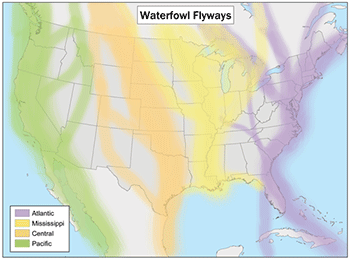
Great Birding in El Paso
By Lois Balin
Many folks from the great state of Texas (and beyond) think the El Paso area is a dusty and drab desert, devoid of wildlife species. They would be wrong; El Paso in far western Texas not only has a unique blend of New Mexico, Mexico, and Texas cultures, and a rich history, but an amazing variety of birds as well. Over 400 bird species have been found here.
The key to the richness of El Paso's birdlife is its geographical location and variety of habitats. El Paso is in the northern part of the Chihuahuan Desert along the Rio Grande. Desert sky islands abound in the region. The Franklin Mountains separate the western, eastern, and northeastern parts of the city. The Trans-Mountain Drive across the Franklin Mountain State Park reaches 5,120 feet while the peak of the North Franklin rises up to 7,192 feet. El Paso is uniquely located in the Central Migratory Flyway situated between the Pacific and Mississippi Flyways, and both eastern birds from the edge of their range and western birds may be found here. The river and north-south trending mountains guide many migrating birds through the El Paso area.
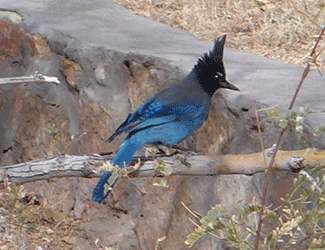
There are numerous mountain ranges found to the south and east of El Paso in western Texas. Within 100 to 200 miles are the Guadalupe and Davis Mountains, respectably. A mere 89 miles northeast of El Paso is the 500,000 acre Lincoln National Forest in New Mexico. Elevations range from 4,000 to 11, 500 feet and habitats include mountain meadows, mixed oak forests, and mixed aspen and coniferous pine and fir tree forests found at higher elevations. In some years, montane birds like Steller's Jay, Acorn Woodpecker, Red Crossbills, and Townsend's Solitaire invade the lower elevations of the El Paso region. Surprise visits from birds that are normally found only in Mexico often enrich the lives of El Paso birders. And, of course, birds unique to the arid Southwest reside here.
Habitats, including desert scrub, desert grasslands, arroyos, canyons, and mountain islands, are the other key to El Paso's rich birdlife. Today, the Bosque habitat along the Rio Grande is virtually gone and most of the wetlands in the El Paso area are artificial, but they are still powerful lures to birds in this arid land. Places like the Rio Bosque Wetlands, Keystone Heritage and Ascarate Parks, plus the McNary and Tornillo irrigation reservoirs, provide desert oases that attracts different birds year round.
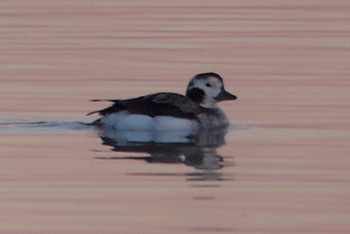
I know the changing of the seasons by the bird species that disappear or arrive in the winter, spring, fall, and summer. When the Western Kingbirds appear, I know that spring is in the air. The birds come and go with the seasons and change from one month, one week or one day to the next. Each season offers a different, rich variety of birds.
From November 2013 throughout Jan 2014 El Paso was visited by at least 36 rare bird species. Some birds were rare for the time of year, others were birds not normally ever found in the region. Water birds dropping in were Bonaparte's Gulls (migrant), Franklin's Gulls (migrant), Mew Gull (breeds throughout, Alaska, Northwest Territories, and southwestern Canada, winters along the Pacific Coast), California Gulls (winter on West Coast), Greater Scaup (breeds on the tundra at the edge of the boreal forest, winters in coastal waters), Black-legged Kittiwake (a small cliff-nesting gull that breeds along the northern coasts and winters out at sea), Hooded Merganser (migrant), Horned Grebe (migrant) and the Long-tailed Duck, formerly known as Oldsquaw (breeds in the Arctic and winters along both coasts of North America).
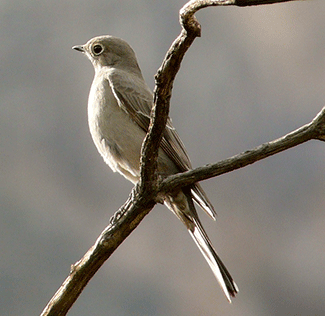
Birds dropped in from the high elevation forests, some staying for a week or more. There was an abundance of Steller's and Scrub Jays, and Acorn Woodpeckers. Red Crossbills, Pygmy Nuthatches, Brown Creepers, Townsend's Solitaire, Mountain Bluebirds, and an immature Pine Warbler paid a visit.
A special treat was the occurrence of a Red-headed Woodpecker (rare to Western Texas) and a Lewis's Woodpecker (not normally found in Texas). Other rare winter bird visitors were Hooded Orioles, Scotts Orioles, Hermit Thrush, Blue-headed Vireo, Blue-gray Gnatcatchers, and House Wrens. There were appearances of rare sparrows including the White-throated, Fox, Cassin's, Harris's, and Lincoln's Sparrow. And of special note are the six species of hummingbirds, rare in the winter, that visited El Paso for varying lengths of time. Between December, 2013 and January, 2014 the Broad-Billed, Anna's, Rufous, Allen's, Broad-tailed, and Calliope Hummingbirds were all here in El Paso at the same time.
El Paso, Texas may be dry and dusty, but it is also a bird bonanza.
Lois is the urban biologist in El Paso.
You Can Help Complete the Cycle
By Mark Klym
Everyone loves butterflies! The beautiful colors and graceful aerobatics of this little insect seems to work its way into our psyche. Their presence never seems to fail to bring shouts of excitement and contented smiles. Most butterflies spend their entire life in a very small area, though some, including the monarch, may migrate great distances.
This year there are strong indications that the monarch migration may be in trouble. Two factors, a lack of roosting sites in the wintering grounds in Mexico and the removal of milkweed from several northern sites seem to have combined to reduce their numbers to near record lows. While the roosting sites in Mexico are beyond the control of readers in Texas, the milkweed situation is not.
Texas has a great variety of milkweed species that monarch caterpillars will feed on. Whether it is the large, showy butterfly milkweed (Asclepias tuberosa) or the more subtle spider milkweed (Asclepias asperula), there is a milkweed species available to fit your urban situation and provide larval food for this beautiful species.
Milkweed is often recommended for control in pastures because of its toxicity (example http://www.theadanews.com/agnews/x212572717/Milkweed-management). As a result, it is often eliminated, or greatly reduced in pastures and agricultural lands when it does appear. In addition, milkweed plants are generally not strong competitors and as such will often succumb to other plants that are planted or maintained around them. These factors have worked together to reduce milkweed numbers, and thus the opportunity to support monarch larvae, have been greatly reduced across much of the United States.
Monarch larvae feed exclusively on milkweed leaves. The toxins in the milkweed are then sequestered in the monarch body and render it distasteful to birds and other predators.
If you have space in your garden where milkweed could be planted it would be helpful for the monarchs this year.
Mark is an information specialist and coordinates the Texas Wildscapes program out of the Austin office.
Back Porch
By Richard Heilbrun
I haven’t been able to spend much time outside lately, but thankfully, the spring weather is quickly nudging me out the door. And I know just what I want to do. We’ve been talking to the folks at www.iNaturalist.org recently and cooked up some neat partnership ideas to enable all Texans to share with us all the cool stuff they see when they’re outside. Here’s how it works: You’re outside gardening, hiking, camping, taking a kid out for a walk, or sitting on your porch and you see something interesting. You snap a picture, upload it to the iNaturalist webpage or their mobile app, and take a guess at what it is. Soon, other naturalists will confirm your identification and just like that, you’ve become a citizen scientist, contributing data to enable wildlife biologists to do their job a little better. This information, combined with thousands of other sightings, helps us to better understand what’s going on with our wildlife and wildlife habitat. This way we can track migration, monitor invasive and exotic species, identify range expansions, and evaluate effects of climate change. Having so many eyes in the field helps Department Biologists set management priorities, and to plan their very limited field seasons.
As an example, someone recently posted a photo of a black-tailed rattlesnake in Central Texas, way outside of the typical range. After confirming that the sighting was legit, our state herpetologist is now looking into adjusting the official range of this species. He otherwise wouldn’t have thought to look in that part of the state. Similarly, our invertebrate biologist is hoping people will contribute bumblebee sightings to iNaturalist, using the project “Bumble Bee Conservation Initiative”. It’s a good way for him to interact with naturalists and understand how these bees are responding to environmental pressures statewide in both urban and rural areas.
My friends and I are competing with each other to see who can post the most sightings, and who can observe the most species this year. I’m doing pretty well, and should inch ahead this spring, with help from my daughter of course. She’s great at finding insects and likes “helping” because she gets to use my phone while we’re hiking. I like it because it gets her out hiking. We really enjoy sharing our wildlife and plant photographs with others, and identifying other people’s sightings. Every now and then a bird or a trail camera photo provides a real mystery, and we can pull out the guide books to solve the puzzle. I’ve found that it adds excitement to my usual hike when I can find a critter or a plant that I didn’t know was hiding nearby.
Next time you go out for a walk, or even sit on your porch watching your bird feeder, I hope you grab a camera, and share your finds with us. You never know what discoveries you’ll make!
Richard is coordinator of outreach and promotion working out of the San Antonio office.

 Texas Parks and Wildlife Department, 4200 Smith School Road, Austin, TX 78744
Texas Parks and Wildlife Department, 4200 Smith School Road, Austin, TX 78744


